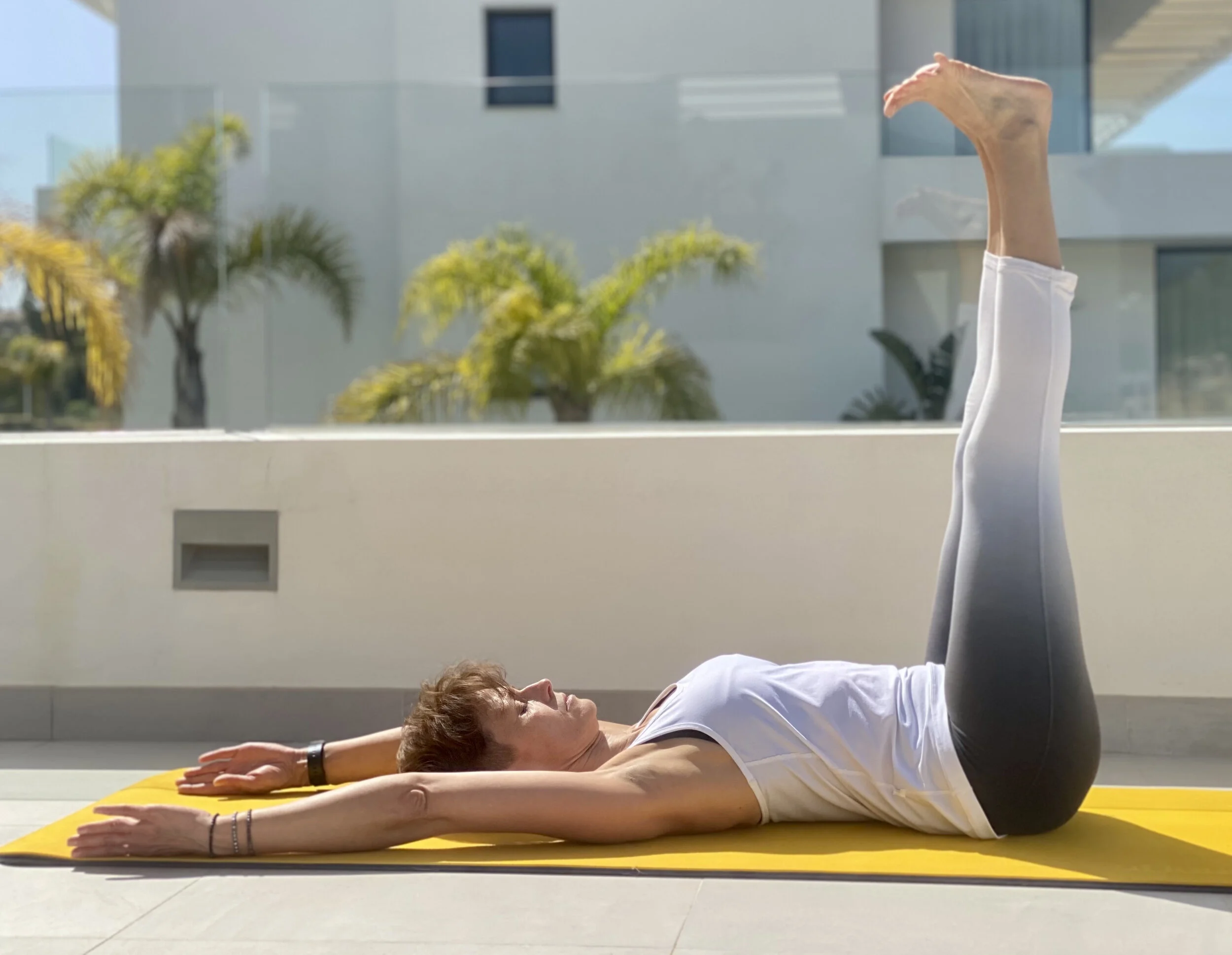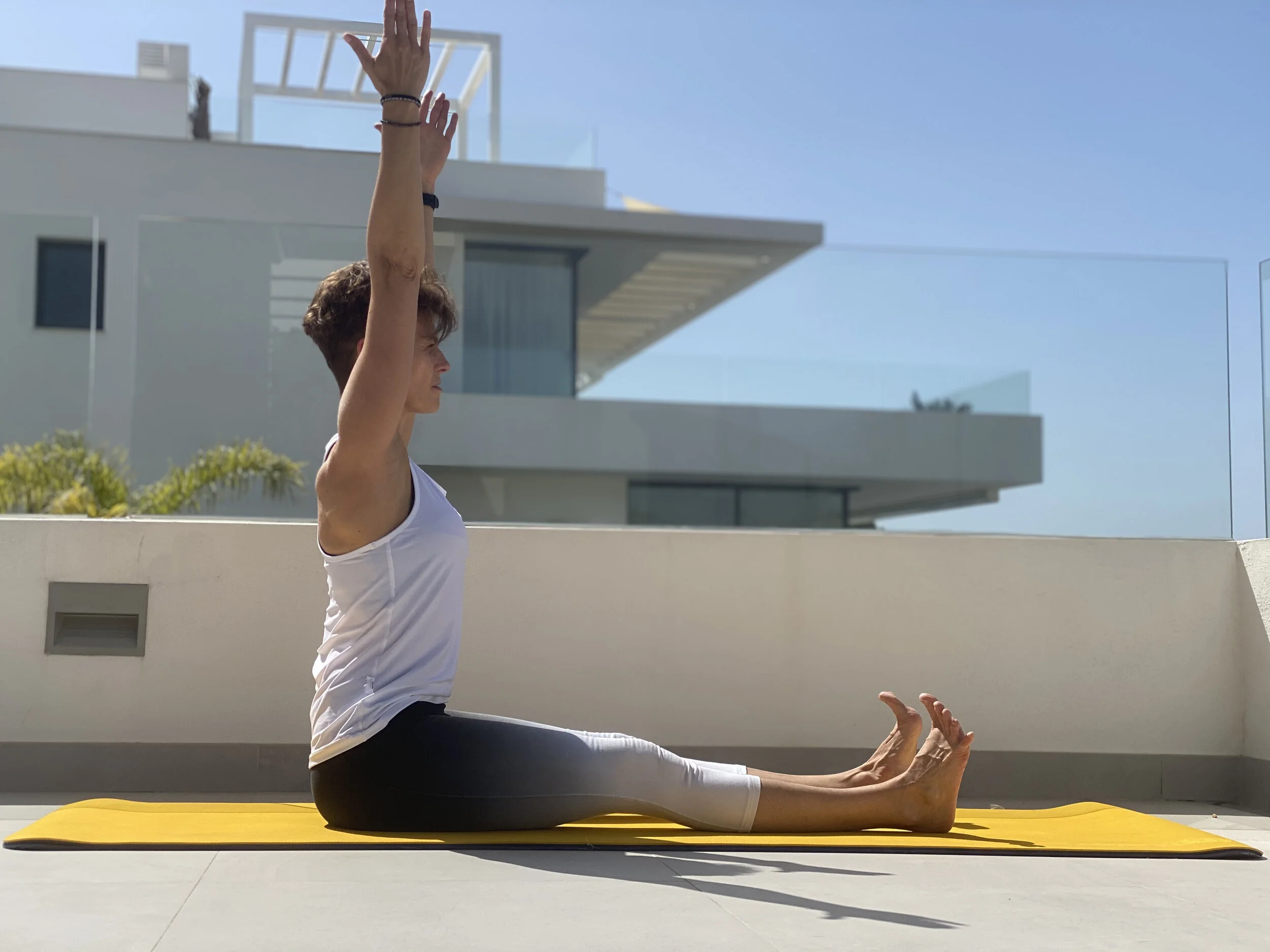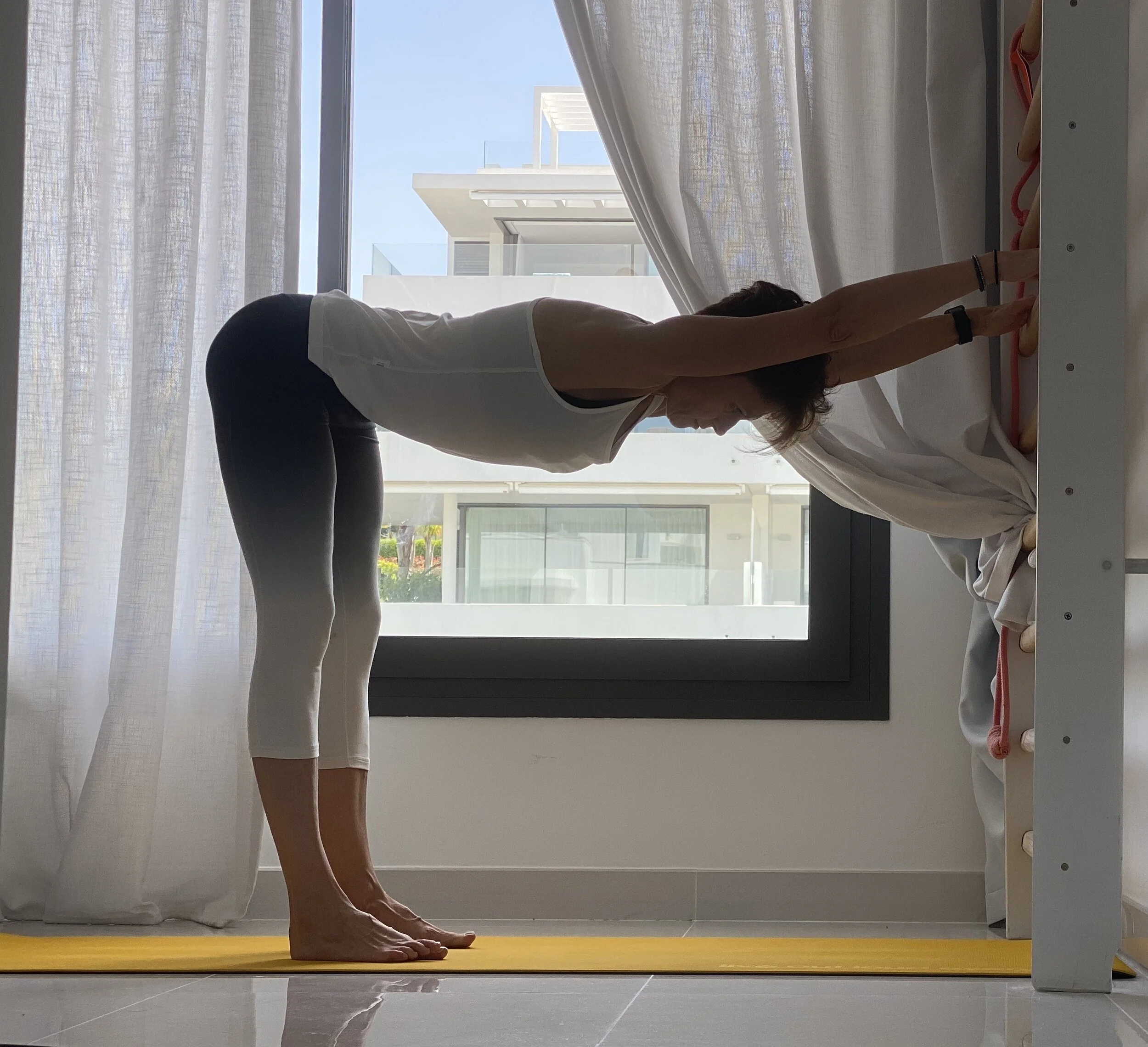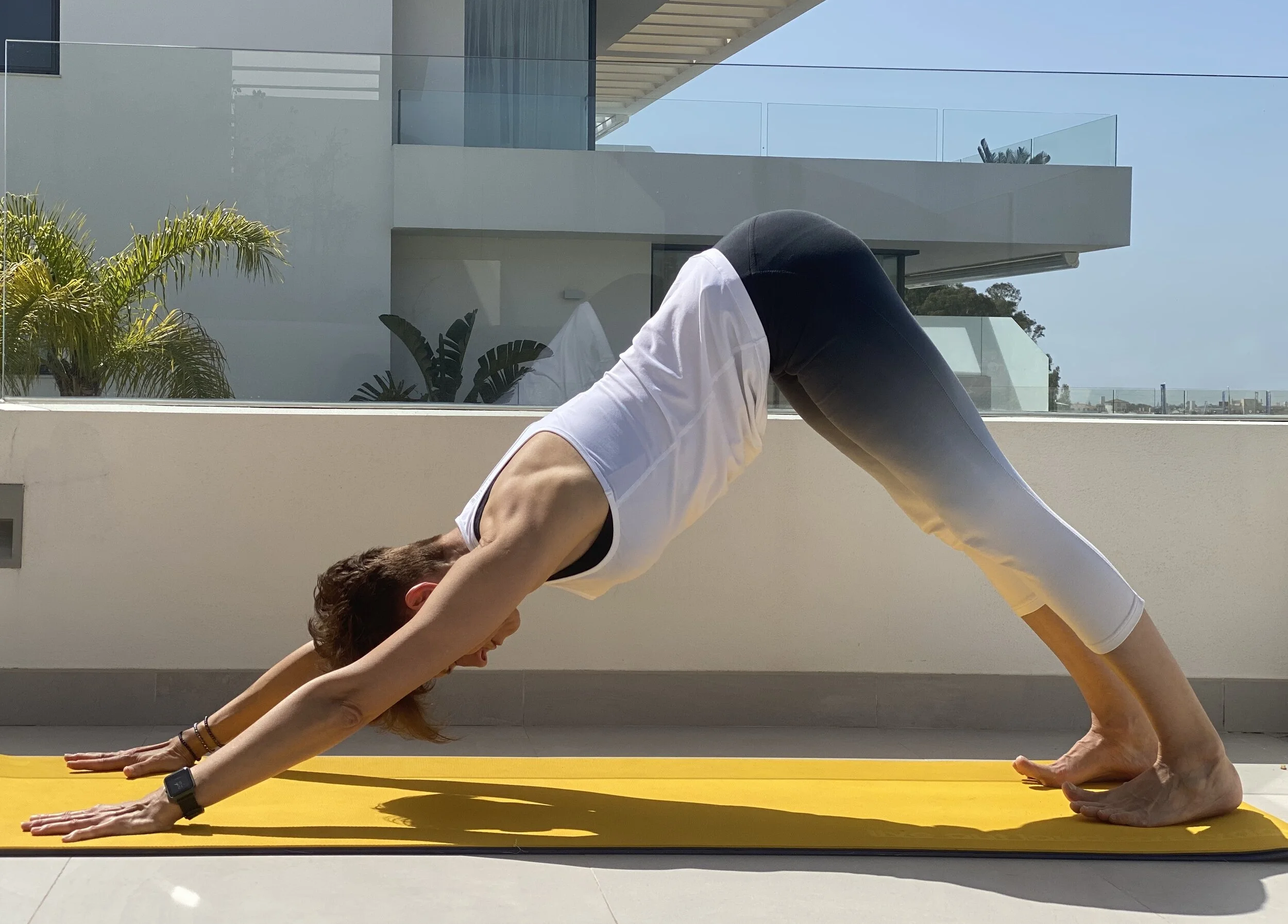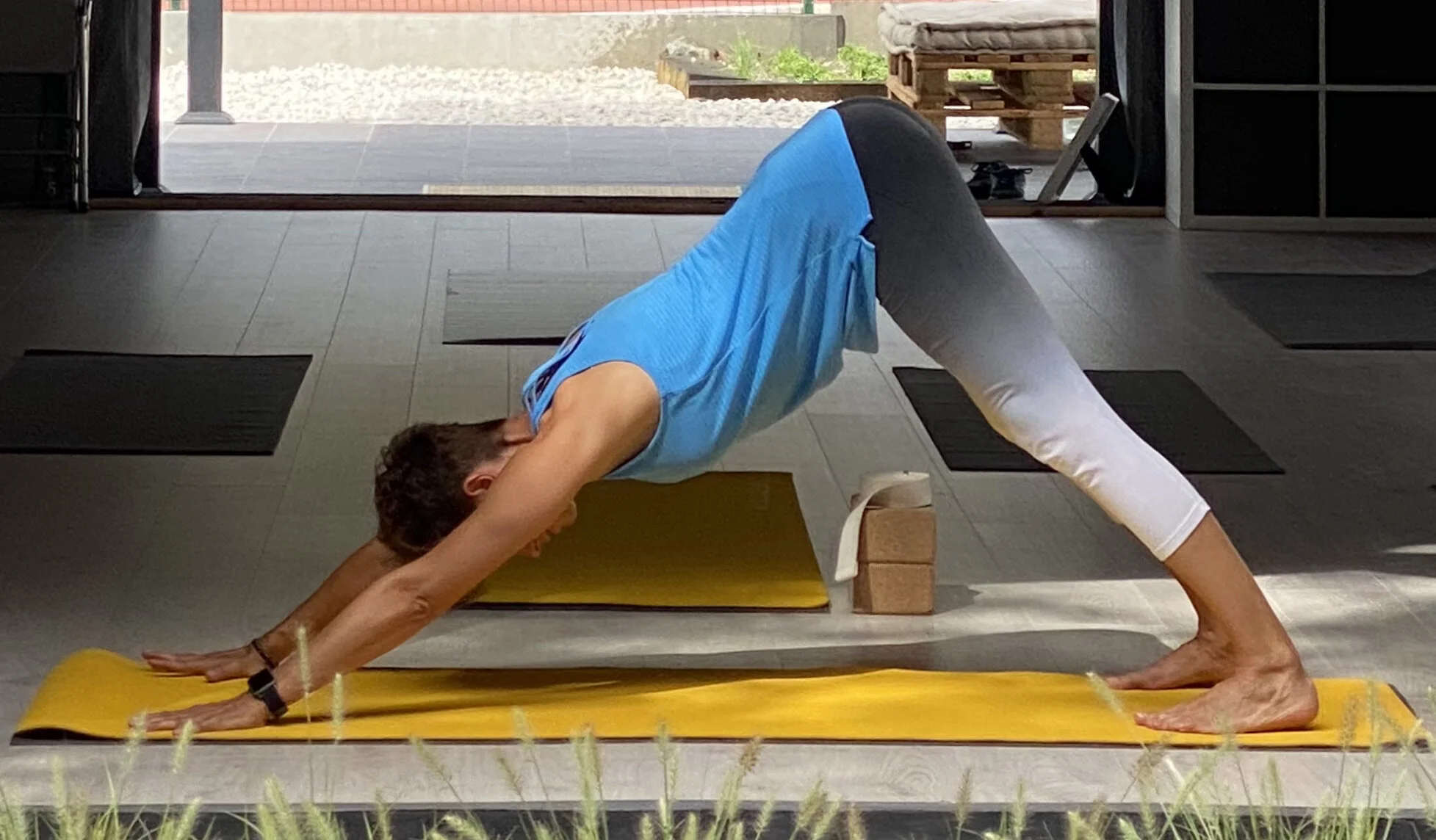Adho Mukha Svanasana - Downward Facing Dog
Downward Facing Dog (Adho Mukha Svanasana) was always one of my favourites. It's fantastic on its own and a perfect transition asana. It's a symmetrical pose that balances the upper and lower part of the body. I love it for my back; it brings relief and the sensation of length.
Downward Facing Dog reminds the shape of the letter V upside down. It is an ideal pose to cultivate a balance between strength and elongation of the body. It requires muscle effort to stabilize joints to lengthen the spine along its axis (technically referred to as "axial spine extension"). Executing this elongation, we aim to create space between the vertebrae to act against gravity. Therefore this alignment with no strain on spinal curves encourages good body posture.
Downward Facing Dog is in the category of asanas that promote axial spine extension. The group consist of poses where the torso is positioned at 90 degrees to the legs.
Starting on hands and knees, position your hands shoulder-width apart, wrists in line with shoulders, creases of the wrists parallel to a shorter age of the mat and "four corners" of each palm pressing against the floor, fingers spread. Keep your spine elongated and your belly toned. Step back with one foot and then the other to Plank pose. Reestablish the spine elongation and lift your hips up and back. You may bend your knees slightly. Stay with your head in line with the spine, so your ears are in line with the upper arms.
We may initiate the entrance into the Downward Facing Dog from the various position like the pose on all fours, Plank (Plankasana), Half Forward Fold (Ardha Uttanasana), Extended Puppy (Uttana Shishosana) etc.
How to execute the lengthening of the spine?
It's a little bit like dancing as one muscle's movement implies the reaction of others. In the course of action, the upper and lower part of the body adjusts to each other to reach the asana's perfect form.
Let's have a look at the base of the pose, starting with the upper body.
When you look at the asana, the situation is pretty straightforward; the hands are pressing against the floor, elbows and armpits are stretched as the arms are overhead. However, while you look from the practitioner perspective, there is much to add. The positioning of your hands is crucial to distribute the weight evenly with no damage on wrists. You press with the mound at the base of your index fingers down to feel the wrist's inner spiral movement. Then with the palms firm on the floor, try to bring your hands towards each other to engage the shoulders' adductor muscles and biceps to create more space in the shoulder joint. The final touch is the outer spinal rotation of the shoulder. This external rotation of the humerus takes the vulnerable area of the danger zone, preventing tendon impingement; you feel your shoulders broadening, and the area around your neck gets more space. The inner spinal rotation of the wrist and outer spinal rotation of the shoulder is to stabilize the arm.
Tips:
in case of tight shoulders, work on opening the chest, stretching through the armpits and straightening arms;
if you are very flexible, try to avoid hanging between your arms, as it may compress your spine. Use your abdominals to align your upper back and lengthen the entire back;
if the mounds at the base of index fingers lift, try to press them down to maintain the inner rotation of your forearm.
The direction of elongation in Down-dog is diagonally up. Try to shift your weight back; it will make your arms lighter. While practising the entrance to Downward Facing Dog, two actions happen in the lower part of the body: legs stretch and heels try to reach the floor.
While you lift your hips, initially keep your knees bend and try to draw your feet together. You will notice a sensation in your lumbar as the pelvis tilts forward. Lift the kneecaps while attempting to extend your knees and internally rotate the thighs.
If your legs' muscles on the posterior part are tight and you round your spine, you might consider lifting your heels and having your knees flexed. Bending knees will allow you to stretch hamstrings in relative isolation. You may also separate your feet wider apart to ease the pelvis's anterior rotation and promote a natural lumbar curve. Feel light engagement of abdominal muscles. The critical interaction happens among the spine's lengthening, the legs straightening and the abdominal muscles tone.
In Downward-Facing Dog, tight calf muscles - gastrocnemius/soleus complex (the muscles responsible for the ankle's plantar flexion) can keep you from getting the heels towards the floor. By engaging antagonist muscle - responsible for dorsiflexing of the ankle, you will be able to relax calf muscles. Therefore attempting to draw the instep towards the shin helps release the calf and enables you to bring the heel closer to the floor.
After lowering heels down, press the ball of the foot into a mat and then distribute the weight across the bottom of the foot to the outer edge; observe how the inner arches lift, and the foot and ankle stabilize.
Benefits:
The Downward-Facing Dog is an excellent pose to restore energy as it increases blood flow to your head. By elevating pressure, it helps with nutrients and oxygen supply. Improves digestion and keeps sexual problems at bay. It promotes a balance between flexibility and strength as it tones the arms and legs, opens and strengthens the shoulders in flexion, lengthens the hamstrings and stretches the calves. It's excellent preparation for the inversion. It tones the nervous system helping to relax, so it is highly beneficial for people with depression.
Stephens, M. (2012b). Yoga Sequencing: Designing Transformative Yoga Classes(Illustrated ed.). North Atlantic Books.
Coulter, D. H., & McCall, T. (2010). Anatomy of Hatha Yoga: A Manual for Students, Teachers, and Practitioners (1st ed.). Body and Breath.
Iyengar, G. (2019). Yoga: A Gem for Women (thoroughly revised 3rd edition, 2019)(Third ed.). Allied Publishers Pvt. Ltd.
https://www.yogajournal.com/poses/types/downward-facing-dog/
https://yogainternational.com/article/view/three-ways-to-practice-downward-facing-dog
https://sequencewiz.org/wp-content/uploads/2016/01/Types_of_EXT_poses.png
https://www.youtube.com/watch?v=kCFOztW7j1s
https://www.yogajournal.com/practice/beginners/how-to/downward-facing-dog-pose-2/
https://www.dailybandha.com/2011/02/how-to-balance-opposites-in-foot-and.html
https://samadhiyogaashram.com/blog/20-health-benefits-of-adho-mukha-svanasana-downward-facing-dog-pose/

